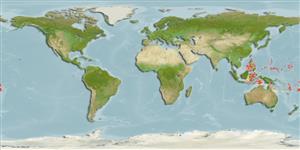Common names from other countries
>
Perciformes/Scorpaenoidei (Scorpionfishes) >
Scorpaenidae (Scorpionfishes or rockfishes) > Scorpaeninae
Etymology: Pteroidichthys: Greek, pteron = wing, fin + Greek, ichthys = fish (Ref. 45335); acutus: Name from Latin 'acutus' meaning sharp; referring to having the longest and sharpest snout of species in the genus Pteroidichthys..
Environment: milieu / climate zone / depth range / distribution range
Ecologie
marien; diepte 73 - 400 m (Ref. 106976). Tropical; 20°N - 27°S, 115°E - 178°W (Ref. 106976)
Verspreiding
Landen | FAO regio's | Ecosystemen | Voorkomen | Point map | Introducties | Faunafri
Western Pacific: from the Philippines, Vanuatu, and the Wallis and Futuna Islands.
Grootte / Gewicht / Leeftijd
Maturity: Lm ? range ? - ? cm
Max length : 4.1 cm SL mannelijk / geslacht onbekend; (Ref. 106976)
Korte beschrijving
Determinatiesleutels | Morfologie | Morfometrie
Dorsale stekels (totaal) : 7; Dorsale zachte stralen (totaal) : 9; Anale stekels: 3; Anale zachte stralen: 5. This species is distinguished by the following characters: A III.5; rigid dorsal-fin spines; relatively long snout with length 18.0-21.2% (mean 19.6%) of SL, and is longer than postorbital length; posterior margin of maxilla just reaching to or short of vertical through the anterior margin of pupil; the distance between tips of lateral lacrimal and first suborbital spines is longer than that between tips of first and second suborbital spines; presence of supplemental preopercular spine; tentacles on supraocular and posterior lacrimal spines are poorly developed, lengths are less than orbit diameter; with few tentacles on trunk and fins; lateral lacrimal and suborbital spines are well developed, with pointed tips; membranes between last spine and fourth soft ray of dorsal fin with a large black blotch (Ref. 106976).
Most probably found on sandy bottoms (Ref. 106976).
Levenscyclus en paargedrag
Maturities | Voortplanting | Spawnings | Egg(s) | Fecundities | Larven
Motomura, H. and Y. Kanade, 2015. Review of the scorpionfish genus Pteroidichthys (Scorpaenidae), with descriptions of two new species. Zootaxa 4057(4):490-510. (Ref. 106976)
Status op de Rode Lijst van het IUCN (Ref. 130435)
CITES (Ref. 128078)
Not Evaluated
Gevaar voor de mens
Harmless
Gebruik door de mens
Tools
Speciale rapporten
Download XML
Internetbronnen
Estimates based on models
Fylogenetische diversiteitsindex (Ref.
82804): PD
50 = 0.5625 [Uniqueness, from 0.5 = low to 2.0 = high].
Bayesian length-weight: a=0.01259 (0.00606 - 0.02615), b=3.03 (2.86 - 3.20), in cm Total Length, based on LWR estimates for this (Sub)family-body shape (Ref.
93245).
Trofisch niveau (Ref.
69278): 3.3 ±0.4 se; based on size and trophs of closest relatives
Weerstandsvermogen (Ref.
120179): Hoog, minimale populatieverdubbelingstijd minder dan 15 maanden (Preliminary K or Fecundity.).
Fishing Vulnerability (Ref.
59153): Low vulnerability (10 of 100).
